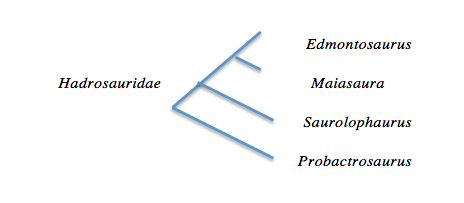Classification
 DOMAIN: Eukarya
DOMAIN: Eukarya
KINGDOM: Animalia
PHYLUM: Chordata
CLASS: Archosauria-“Ruling Reptiles”
ORDER: Ornithischia- “Bird Hipped”
FAMILY: Hadrosauridae- “Duck-billed dinosaur”
GENUS: Maiasaura- “Good Mother Lizard”
SPECIES: Maiasaura peeblesorum
(Dinosphere Dinosaurs, 2014)
To better understand where the Maiasaura peeblesorum
came from, you must first unders tand how it received its
classification. Latin, considered a dead language, is
used to classify organisms since common names can easily be
applied to the wrong organism or to multiple organisms that are
very different from each other. (Volk, T. and Snively, E. 2014,
personal communication: class lecture). The following breakdown
should allow a better insight into the classification of
Maiasaura.
tand how it received its
classification. Latin, considered a dead language, is
used to classify organisms since common names can easily be
applied to the wrong organism or to multiple organisms that are
very different from each other. (Volk, T. and Snively, E. 2014,
personal communication: class lecture). The following breakdown
should allow a better insight into the classification of
Maiasaura.
Domain Eukarya: Eukarya is an omnipotent term referring to eukaryotic organisms, organisms with a true nucleus, and organisms that have membrane bound organelles. An example of another eukaryote in the Sago Lisa Moth Orchid.
Kingdom Animalia: Animalia refers to what we commonly call animals. These organisms are motile, lack a cell wall, and have haploid gametes created from meiosis. There are many different types of organisms belonging to the Kingdom Animalia, one example being the Sea Otter.
Phylum Chordata: The predominant characteristics that define this phylum include pharyngeal gill slits and a notochord at some point during development, three germ layers (ectoderm, endoderm, and mesoderm), and bilateral symmetry. Another organism classified in this phylum is the Atlantic Cod.
Class Archosauria: In Latin, Archosauria translates into “ruling reptiles,” which were separated from other organisms by single openings on each side of the skull and in front of the eyes. These organisms are first recorded around 250 million years ago in the late Permian period. The only living members include crocodilians and birds (Great Archosaur Lineage, 2005). Another example of an archosaur is the well-known Velociraptor.
Order Ornithischia: From the Latin word meaning “bird-hipped.” This order can be confusing because birds are more closely related to the Saurischia, or “lizard-hipped” dinosaurs. This order refers to organisms that have a pelvis where the pubis points backwards and the ischium and pubis run parallel to each other (Ornithischian Dinosaurs, 2005). If you wish to see another example of a Ornithischia, check out the Stegosaurus, or the "armoured lizard."
Family Hadrosauridae: In Latin Hadrosauridae refers to “duck-billed” dinosaurs. These organisms were characterized by their duck bills, stiff tails, and sturdy bones (Introduction to Hadrosaurs, 2005).
Genus Maiasaura: In Latin Maiasaura translates into “Good Mother Lizard.” Believed to take care of their offspring while they were vulnerable at a young age, Maiasaura was termed “good mother” since this was the first time it was found that dinosaurs looked after their young (Maiasaura, 1996).
Species Maiasaura peeblesorum: Peeblesorum refers to the Peebles family who owned land in the badlands close to where Maiasaura peeblesorum was discovered (Dinosphere Dinosaurs, 2014).
Hopefully, this breakdown has allowed you to better understand Maiasaura and how complex and amazing its classification is. If you wish to continue learning about Maiasaura visit one of the links above, possibly look at its reproduction to see more about how it was termed the “good mother lizard.”